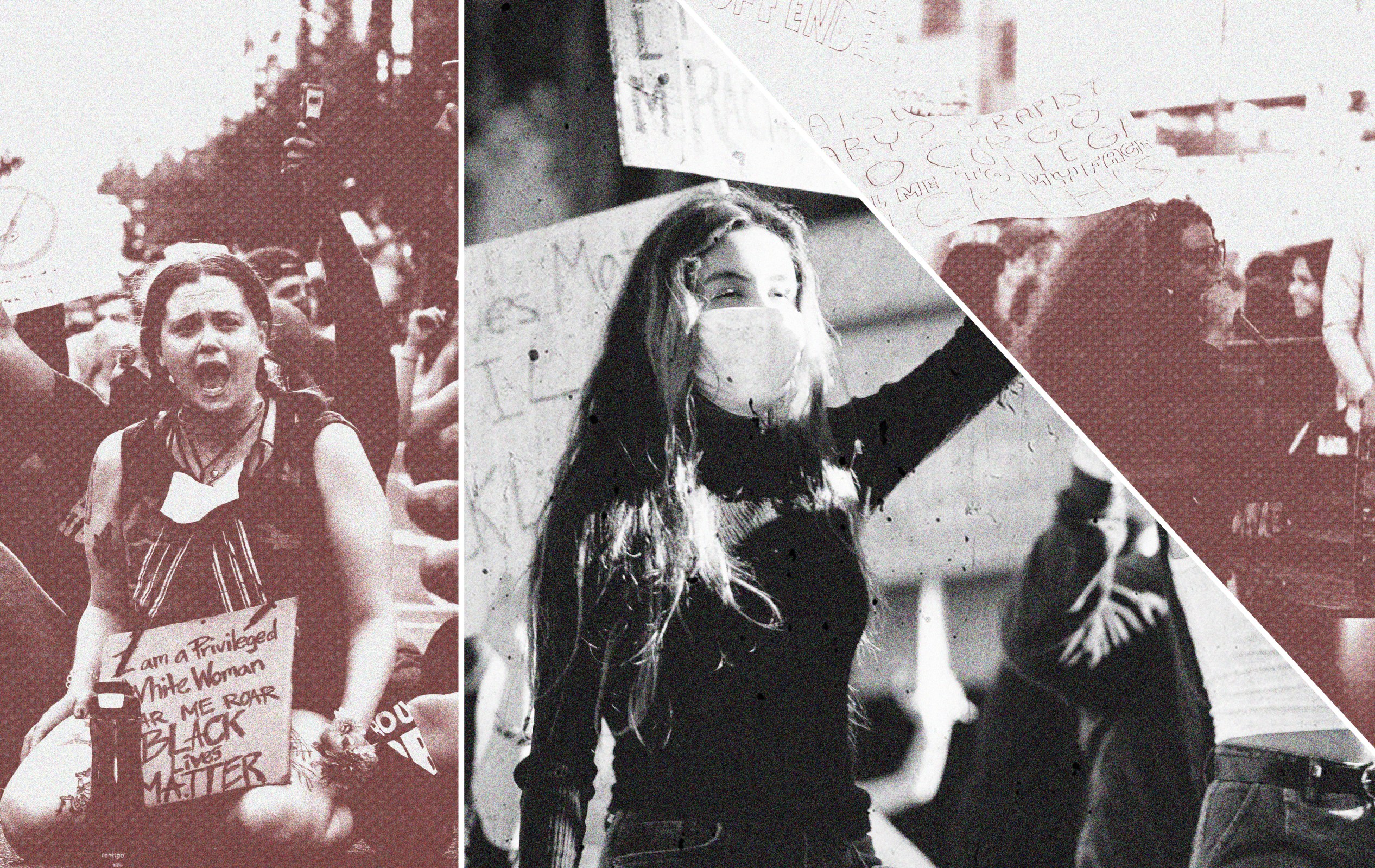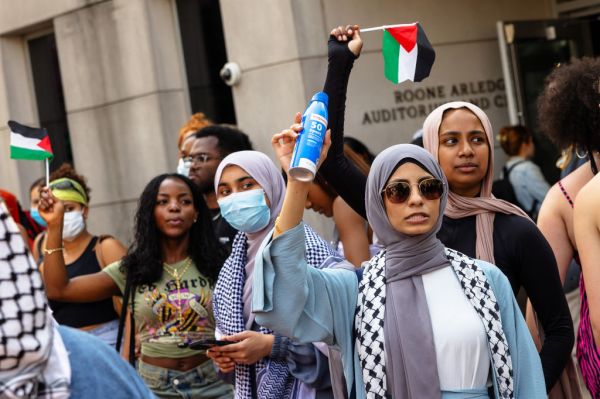Banging drums in Columbia University’s Butler Library in early May, a group of protesters shouted: “Free, free Palestine!” When campus security shut the doors of the reading room, effectively trapping the demonstrators in, their chants turned into pleas. One person tried to break through to the exit, and a scuffle broke out. “You’re hurting him, stop!” a girl cried out. By the end of the occupation, 80 protesters had been arrested. Sixty-one of them were women.
The Columbia protest made national news in the U.S., but the striking gender imbalance of its participants went largely unnoticed. It shouldn’t have. Whether the cause is Gaza, climate change, Black Lives Matter, or feminism, overrepresentation of young women has become the norm in progressive activism. And this shift signals a susceptibility to ideological extremism.
Women moving to the left is a global phenomenon. A 2020 study on the Extinction Rebellion environmental movement in the U.K. (a group which regularly engages in civil disobedience such as blocking traffic and vandalism) described it as a “highly feminised” protest culture. Surveys have found that attendance at climate demonstrations in cities around the world tends to be about 60 percent female, and recent American progressive movements—such as Black Lives Matter and the Gaza encampments, many of which were supported or led by the female-founded Jewish Voice for Peace—have likewise been launched and sustained by women.
Data published by John Burn-Murdoch in the Financial Times confirms that the shift spans continents. In South Korea, the United States, Germany, and the United Kingdom, Gen Z women have shifted toward “hyper-progressive” political positions, while men in the same age cohort have held steady or moved to the right. In the U.S., according to Gallup data, women ages 18 to 30 are now 30 percentage points “more liberal” than their male peers.
There is growing awareness of how young men can be drawn into far-right extremism or misogynistic subcultures, but we in the media—and society more broadly—pay less attention to how young women become drawn into political subcultures. Indeed, the terms “radicalization” and “women” are rarely—if ever—seen together. This oversight has consequences, because radicalization—defined as rigid commitment to an ideological cause to the point where it distorts one’s worldview, harms mental health, undermines relationships, or disrupts functioning—is not a male-only phenomenon.
Of course, political engagement is not, in itself, cause for concern. The fact that young women attend climate protests or BLM marches is not evidence of extremism. But if we imagine political engagement on a spectrum, the extreme end is not benign. And the failure to recognize this has allowed radicalism to flourish.
The escalating tactics of climate activism illustrate the pattern. Last year, three female members of the British climate action group Just Stop Oil, alongside two male members, were sentenced to prison for climbing onto overhead signs of a major motorway, forcing police to shut down traffic. One of the men received a five-year sentence, while the others were sentenced to four years each. Two trucks collided and one police officer was injured amid the chaos. The stunt created major gridlock that led to people missing medical appointments, exams, and flights.
Another tactic popular with climate protesters is the defacing or attempted vandalism of artwork: Vincent Van Gogh’s “Sunflowers” was targeted by two female activists in London, while Edgar Degas’ “Little Dancer Aged Fourteen” was splashed with paint by two activists, one male, one female, at the National Gallery of Art in Washington, D.C.
Men are still engaging in radical left-wing protest, of course, with Aaron Bushnell being a salient example. But we find it easy to recognize radicalization when it happens in young men, while romanticizing or ignoring the same phenomenon in women.
In my home country, Australia, a female protester cemented her arm into a car near a major freeway to protest a weapons exhibition in Melbourne last year. In Sydney, a 22-year-old woman shut down the Harbour Tunnel during peak-hour traffic by chaining herself to her steering wheel. Another offender, Deanna “Violet” Coco—who helped shut down the West Gate Bridge in March 2024, delaying emergency services and forcing a pregnant woman to give birth roadside—recently had her jail sentence tripled on appeal after a judge noted that she had 15 court appearances in less than four years.
Sometimes, mainstream institutions don’t just overlook female extremism—they actively encourage it. In Australia, Elsa Tuet-Rosenberg, a Melbourne-based activist who helped dox more than 600 Jewish-Australian creatives following Hamas’ attacks on October 7, 2023, has delivered taxpayer-funded “anti-racism” training to primary schools through her own consulting firm. Clementine Ford, a feminist author with a large social media following, has spread conspiracy theories about Israel, dismissed the mass rape of Israeli women on October 7 as unverified, and accused the IDF of manufacturing hostage deaths—all while remaining associated with a prestigious publisher, and being featured as a speaker at major public events.
This dynamic is perhaps best reflected in the career of Greta Thunberg. Since she began skipping school at the age of 15 to demand action on climate change, Thunberg has been showered with encouragement and awards. She was named the youngest-ever recipient of Time’s Person of the Year honor in 2019 following her “How Dare You” speech at the United Nations. She has since received multiple Nobel Peace Prize nominations and an array of awards from media, philanthropic, scientific, and academic institutions, including several honorary doctorates. No matter what one thinks of Thunberg’s activism, it is hard to imagine a young man receiving the same level of global adulation. A “Gus” Thunberg who encouraged children to skip school would be more likely to be called in for detention than invited to the U.N.
Thunberg’s trajectory illustrates a broader pattern: Radical behavior from young women is not just tolerated but actively encouraged through awards, platforms, and institutional support. This creates a feedback loop. The incentive structures that rewarded Thunberg so handsomely for her climate activism have since encouraged her to expand into pro-Palestinian activism. “If you, as a climate activist, don’t also fight for a Free Palestine and an end to colonialism and oppression all over the world,” the now 22-year-old activist declared at a demonstration in Milan last year, “then you should not be able to call yourself a climate activist.” This demand for ideological purity across unrelated causes is a signature move of female radicalism, and a feature of how “intersectionality” is used in activist cultures. What began as a framework for understanding different forms of disadvantage, and how they can overlap, is now a litmus test for moral conformity—not only on issues like climate and Gaza, but also on heavily charged topics like abortion, where deviation from the dominant view is treated as betrayal. While generally not coercing people through violence, female radicals coerce through threats of shaming and social exclusion.
It’s easy to dismiss such actions as inconsequential compared to the violence of male radicals. Women rarely engage in political assassinations or mass shootings, the way a small subset of fanatical men do. But the blocking of infrastructure and the vandalism of cultural property inflict a real toll—on the public, yes, but also on the activists themselves. Social coercion through threats of exclusion causes young women across the world significant anxiety. More concerning is that this phenomenon remains largely unstudied. A growing number of academics are researching how and why young men become radicalized, but they generally exhibit little interest in addressing similar processes in women—with the exception of female radicalization in the context of Islamic extremism.
Still, existing studies in moral psychology and social behavior offer valuable clues about the underlying dynamics. Moral Foundations Theory, developed by the social psychologist Jonathan Haidt and colleagues, argues that human moral reasoning is built on a set of intuitive foundations: Loyalty, Authority, Care, Fairness, and Purity. A 2020 study using this framework across 67 countries found that women consistently scored higher than men on the latter three. The Care foundation relates to our sensitivity to the suffering of others—an extension of the instinct that compels parents, especially mothers, to respond to infant distress. Fairness is tied to notions of justice and equality, while Purity—originally evolved to protect against disease—can manifest as a desire for ideological or moral cleanliness. These tendencies, while adaptive in many contexts, can also make young women particularly receptive to political narratives framed in terms of trauma, injustice, and moral absolutism. And they also create vulnerability to ideologies that use victimhood as currency.
The way young women organize their social lives compounds this vulnerability. Studies by developmental psychologist Joyce Benenson have found that female friend groups tend to be less resilient than those of males, and many women suffer from an intense fear of social exclusion. The pressure to “fit into” a group is stronger for girls than for boys, possibly leading girls to support beliefs or ideas out of a desire for social harmony rather than true conviction.
These dynamics create perfect conditions for availability cascades, a social phenomenon—described by Cass Sunstein and Timur Kuran in 2007—in which a group comes to hold a belief through chain reactions. Take, for example, Greta Thunberg’s declaration that climate activists must also fight for Palestinian liberation. In progressive social circles where Thunberg is held up as a moral authority, some girls might think this argument makes no sense—but they won’t say so. Collectively, such silence can be mistaken for universal agreement, pressuring others to mold their views to fit in. This artificial consensus can snowball, as individuals assume everyone else in their peer group agrees with a given sentiment, completely unaware that many don’t. The result is a fragile system held together by fear rather than belief.
Social media intensifies these cascades. When female friendship groups migrate online, superficial displays of consensus—the sharing of memes, badges, and hashtags—can feel mandatory. Platforms like Instagram and TikTok serve up a stream of trauma-related content—activating the care instinct—while exposing young women to constant cues that their safety, belonging, and self-worth depend on adopting “pure” ideological postures. The result is a technological and ideological hijacking of female psychology.
It should come as no surprise, then, that progressive girls were the first group to suffer a major mental health decline following the mass adoption of smartphones and social media around 2012. As Haidt points out in his book, The Anxious Generation, and in his newsletter, After Babel, Gen Z girls have been socialized online in a culture based on hypervigilance toward harm, accompanied by demands for moral absolutism and purity.
This represents a new form of radicalization that operates differently from its male counterpart. When ideology takes over female friendship groups, the process is less violent and more relational, driven by peer pressure, emotional reasoning, and fear of social exclusion. It thrives in spaces that appear safe and caring, but beneath the language of justice lies a brittle conformity.
The implications extend beyond individual well-being to institutional trust and social cohesion. When compassionate instincts become misdirected and the instinct for purity leads to coercion, the resulting absolutism becomes toxic. A formal study of female radicalization would need to examine evolutionary psychology, social psychology, and the incentive structures that reward extremism. Recognizing this pattern is the first step toward protecting young women from the misguided narratives that exploit their moral sensitivity. But to change it, we must first name it.










Please note that we at The Dispatch hold ourselves, our work, and our commenters to a higher standard than other places on the internet. We welcome comments that foster genuine debate or discussion—including comments critical of us or our work—but responses that include ad hominem attacks on fellow Dispatch members or are intended to stoke fear and anger may be moderated.
With your membership, you only have the ability to comment on The Morning Dispatch articles. Consider upgrading to join the conversation everywhere.